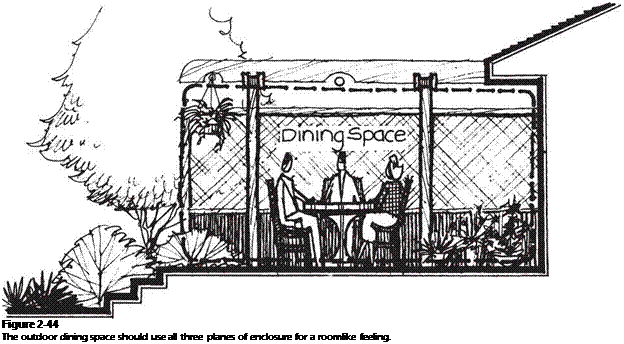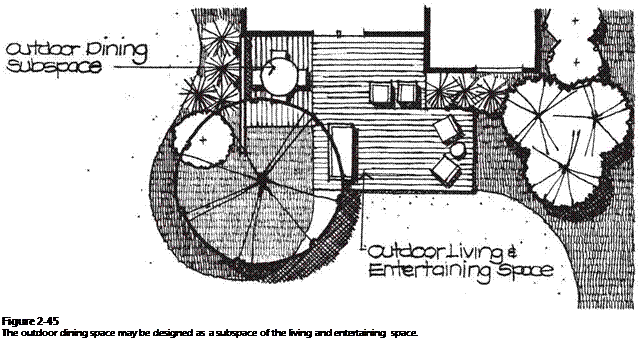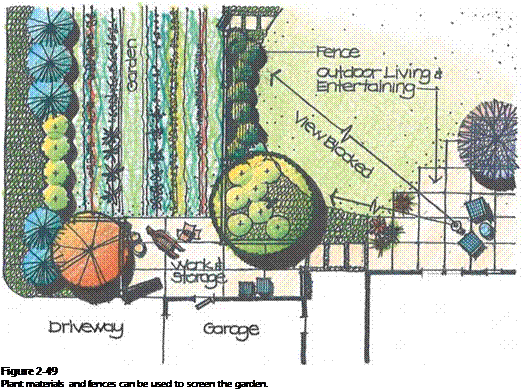Several other outdoor spaces or rooms also deserve attention. These include the recreation space, work/storage space, and garden space. Like the outdoor rooms already discussed, these spaces have a number of considerations that should be taken into account when designing them.
Recreation Space The outdoor recreation space should of course be located on flat ground, with a slight slope for adequate drainage. It should not be too close to other
 |
 |
spaces that require peace and quiet or where delicate elements such as flowers and potted plants are located. The shape of the recreation space should be appropriately and adequately sized for the type of recreation. Beyond the functional requirements, the recreation space should be defined as an outdoor room. It should have a feeling of spatial definition whether it is by implication or actual physical enclosure. The lawn area is often an undefined entity that takes up all of the remaining area of the site after other elements are located. The edge and shape of the lawn area should not be an

afterthought or be left to chance. As discussed later, the outer shape and outline of the lawn area should be given as much study as the form of any other space on the site. The edge of the lawn area can be established by a mulch bed, ground cover, masses of shrubs, trees, walls, and fences (Figure 2—46). Pools are a specialty item in some regions of the country, but quite typical in others. In all cases, thought should be given to (1) size of the pool desired based on the intended use (leisure, serious swimming, visual focal point), (2) adequate pedestrian circulation around the pool, (3) location of the pool in relation to the other functions on the site, (4) location of the pool’s mechanical system and equipment, (5) ease of access by heavy equipment for constructing the pool, and (6) local ordinances governing fence type and height around the pool for protection of children and animals. Although there may be other important factors to consider, it should be stressed that a pool is likely to be the dominant element of a design owing to its uniqueness, thus making it an extremely important element requiring extensive study.
Outdoor Work/Storage Space The outdoor work/storage space is primarily a utilitarian room on the residential site. Its function is to store such things as firewood, garden and recreation equipment, and other items that are too large or unnecessary to keep in the house, garage, or cellar. The work/storage space is also a place where work can be done (light construction, potting plants, equipment repair, etc.). If properly designed, this space can act as an outdoor workshop. For these functions to occur, the outdoor work/storage space should be located near the garage or basement door so materials and equipment can be easily carried between them (Figure 2—47). The
![]()
|
|
|

work/storage space should have a hard, durable, and nonslip pavement surface. A wall or fence may be needed to enclose the work/storage space for security and/or to screen it from other spaces on the site. Inside the work/storage space, a work/potting bench, shelves, and enclosed or covered storage might be provided. Much of this can be designed and built in a coordinated manner (Figure 2—48).
Garden Space The garden space is another utilitarian area on the residential site. It exists as a work or hobby space for raising fruits, vegetables, and perennial flower beds. To function adequately, the location of the garden space is critical. It should be placed on fertile, well-drained soil on flat ground. The garden should be situated so it has adequate exposure to sunlight. If continuous sun exposure is not possible throughout the day, then morning and midday sun is preferred. Mid – to late-afternoon sun is the least desirable because it is the hottest and most drying. Ideally, the garden needs to be near a water source such as a well or outside water spigot. It is inconvenient if water hoses have to be stretched long distances to reach the garden. The garden space should also be located so it won’t become an eyesore, especially during those times of the year when vegetables and other plants are not growing. It can be quite unsightly to look at a bare earthen patch in the backyard. Shrubs, fences, or walls may be used to provide varying degrees of screening of the garden (Figure 2—49). All of this suggests
 |
that the back corner of the property, where the garden is commonly located by default on many sites, isn’t necessarily the only or best location.
A few other ideas might also be considered for a vegetable garden. One is to incorporate the planting of vegetables with other plants in the yard rather than creating a separate vegetable garden. Many vegetables have attractive flowers and foliage texture. This concept treats vegetables like other plant materials that are used for a variety of functions, such as creating the edges of space or establishing points of interest (Figure 2-50).
|

Another idea is to design the garden as a series of raised garden plots. This gives the garden a neat and organized appearance and makes it easier to tend the vegetables while standing. Raised plots also make it possible to prepare one’s own mix of fertile soil.
SUMMARY_____________________
Outdoor rooms are the residential designer’s building blocks. They should be designed in imaginative yet practical ways to create exterior residential environments that enhance the quality and enjoyment of life. Having completed this chapter, you should now have an understanding of the following: [1]
• Suggestions for size, proportion, relation to front door movement, pavement, vertical and overhead planes, and use of feature elements in the outdoor foyer space
• Guidelines for the outdoor living and entertaining space including size and proportion, subspaces, arrangement of furniture, circulation, pavement, vertical and overhead planes, and connections to adjoining outdoor and indoor areas
• Recommendations for the outdoor food preparation space such as location, circulation, relation to wind direction and nearby plant materials, and ways to accommodate cooking tools and equipment
• Criteria for the outdoor dining space such as location and size, plan proportion, and planes of enclosure
• Requirements of the outdoor recreation space(s) including size, noise, and needed equipment
• Suggested location, pavement surface, enclosure, and ways to support potting, crafts, and other related gardening activities in the outdoor work/storage space
• Guidelines for the garden that consider location, sun, access of equipment, connection to utilities, and views




